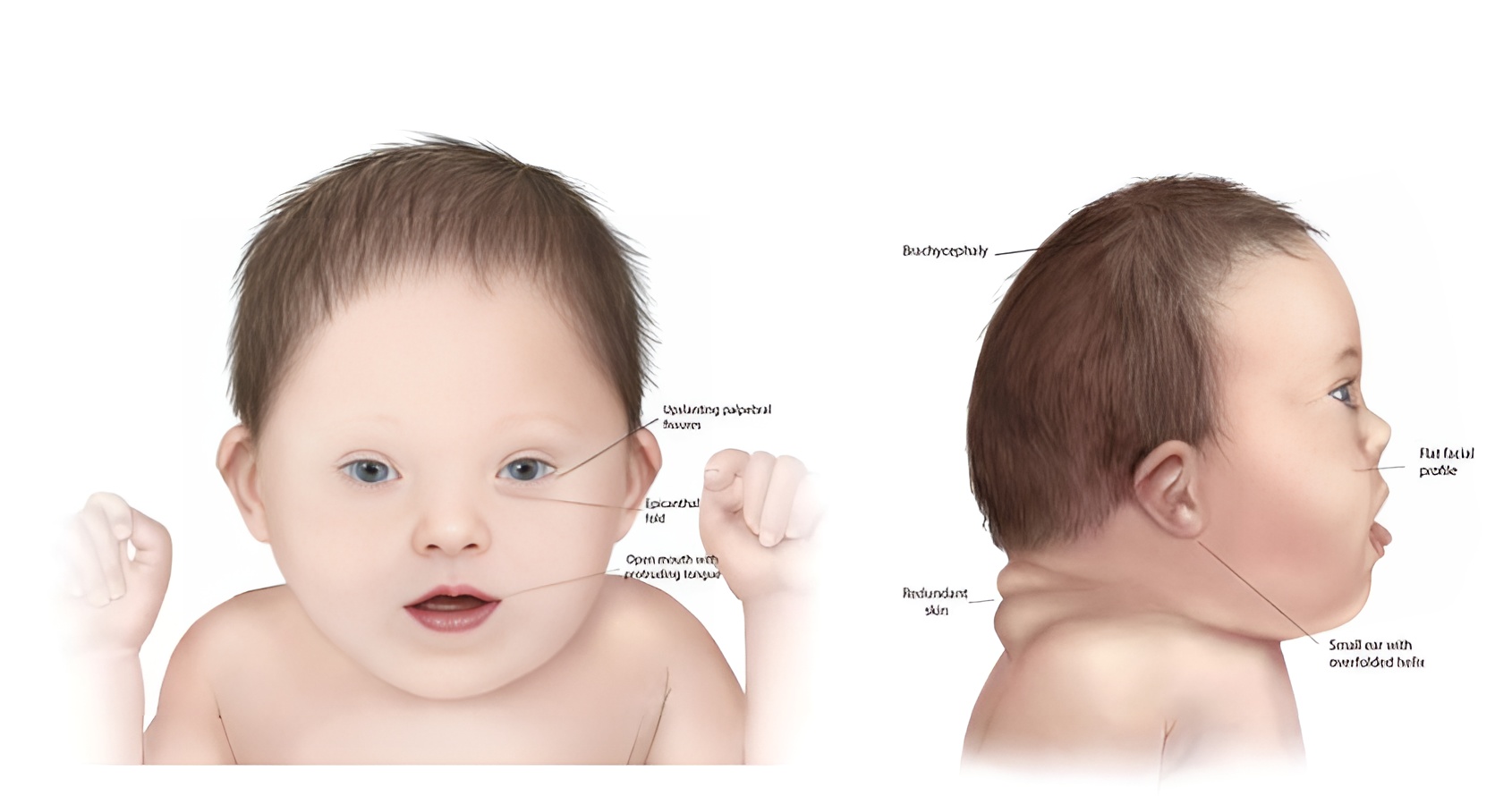Understanding Down Syndrome: Causes, Types, and Management
What is Down syndrome?
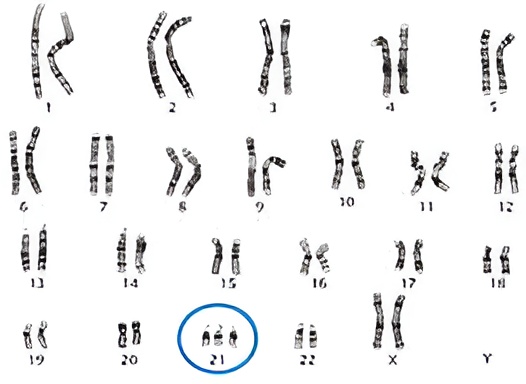
Normally, humans have 46 chromosomes in other words 23 pairs (each pair contains two chromosomes one from each parent). Chromosomes carry genes which are units of inheritance and are responsible for an individual's physical and intellectual development. Down syndrome is a condition when there is the presence of an extra chromosome 21. This extra chromosome causes developmental and morphological characteristics in Down syndrome.
What are the common features of Down’s syndrome?
Children with Down syndrome may have unique features in varying degrees of severity or some cases not at all. The following are some of the common features of the syndrome,
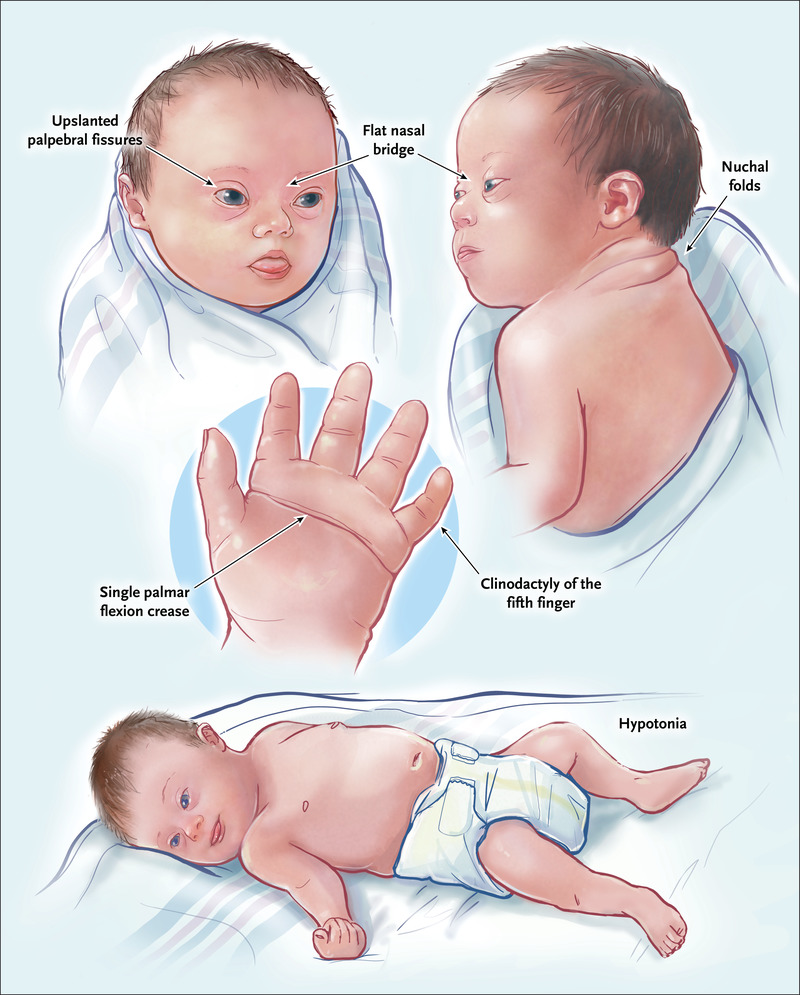
Physical features
- Small head
- Flattened face
- Eyelids: Upward slanting
- Eyes: Tiny white spots on the iris called Brushfield’s spots
- Small ears
- Protruding tongue
- Small hands and feet
- Short broad hands with a single palmer crease
- Poor muscle tone
- Short height
- Excessive flexibility
Intellectual impairment
People with Down syndrome have an IQ between mild to moderate low range. Speech is slow and both short and long-term memory are affected.
Other impairment
Down syndrome can also cause medical abnormalities such as
- Congenital heart defect
- Gastrointestinal defects
- Immune disorders
- Sleep Apnoea
- Obesity
- Dementia
- Leukaemia etc.
How common is Down syndrome?
The incidence of Down syndrome is between 1 in 700 to 1 in 1100 live births all over the world. Every year approximately 3000-5000 children are born with Down syndrome.
History of Down syndrome
Down syndrome was first accurately described by Dr. John Langdon Down in 1866, and hence came to be known as Down syndrome. In 1959, Dr. Jerome Lejeune identified it as a chromosomal disorder and in the year 2000, a team of scientists identified 329 genes that are present in chromosome 21. This led to much ground-breaking research on Down syndrome which has opened the door for understanding and managing the condition.
Types of Down Syndrome
The presence of extra chromosome 21 in Down syndrome is due to the result of abnormal cell division originating from either of the parents. Down syndrome can be of different types as follows
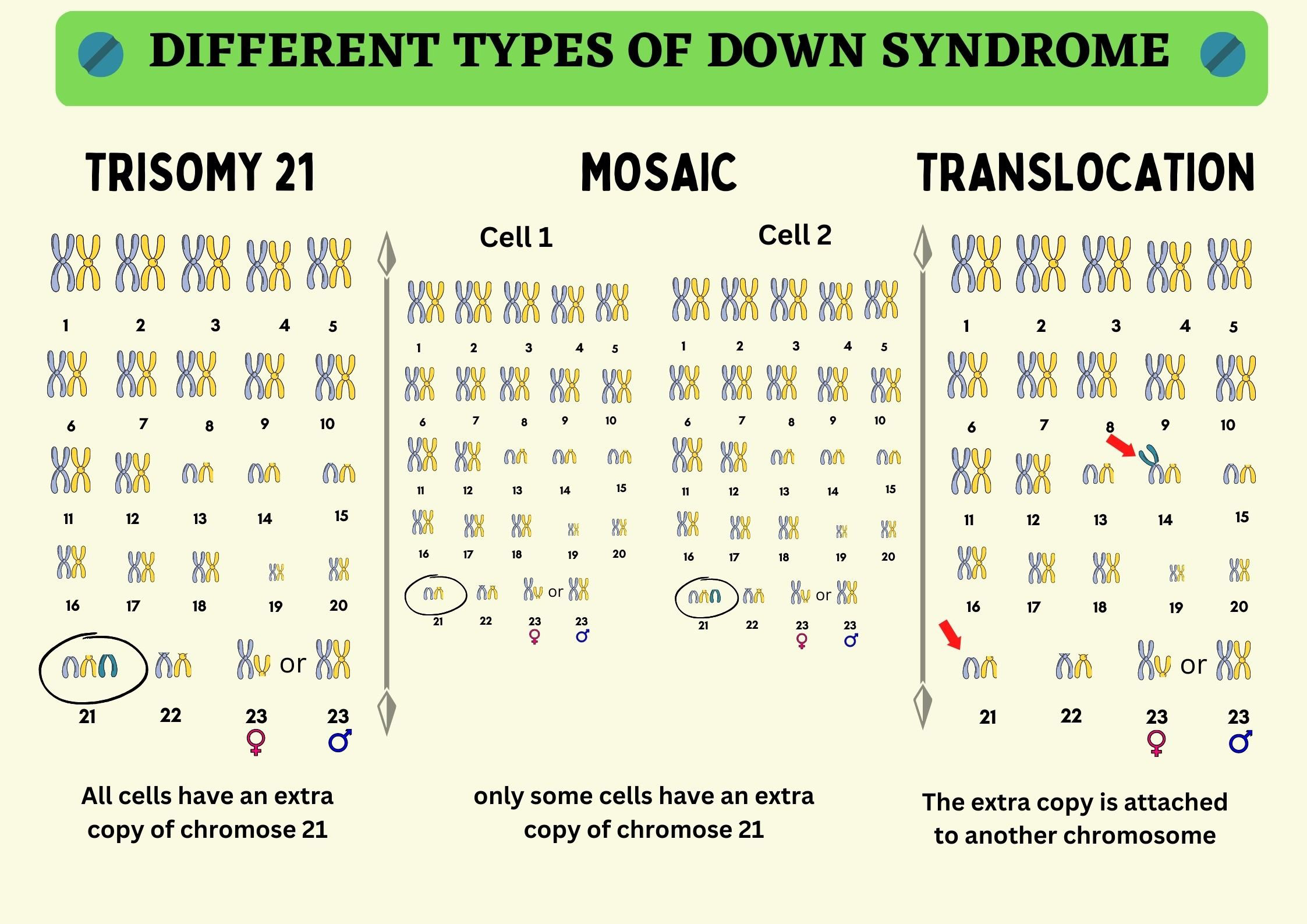
Trisomy 21:
This type accounts for 95% of cases in Down syndrome. Here, the embryo contains three copies of chromosome 21 due to abnormal separation during or before conception. As a result, every cell in the body has an extra chromosome.
Translocation Down syndrome:
This type accounts for around 4% of cases. Here the extra chromosome 21 is attached to another chromosome (usually chromosome 4), hence the final chromosome number remains 46 but the extra chromosome 21 causes the Down’s syndrome feature.
Mosaic Down syndrome:
This type is the least common kind accounting for around 1% of total cases. Unlike the first type trisomy 21, here the presence of extra chromosome 21 is present in only one of the initial cell divisions instead of all. This results in some cells containing 47 chromosomes and others containing 46 chromosomes. Individuals with mosaicism may have fewer characteristic features than the other two types of Down syndrome.
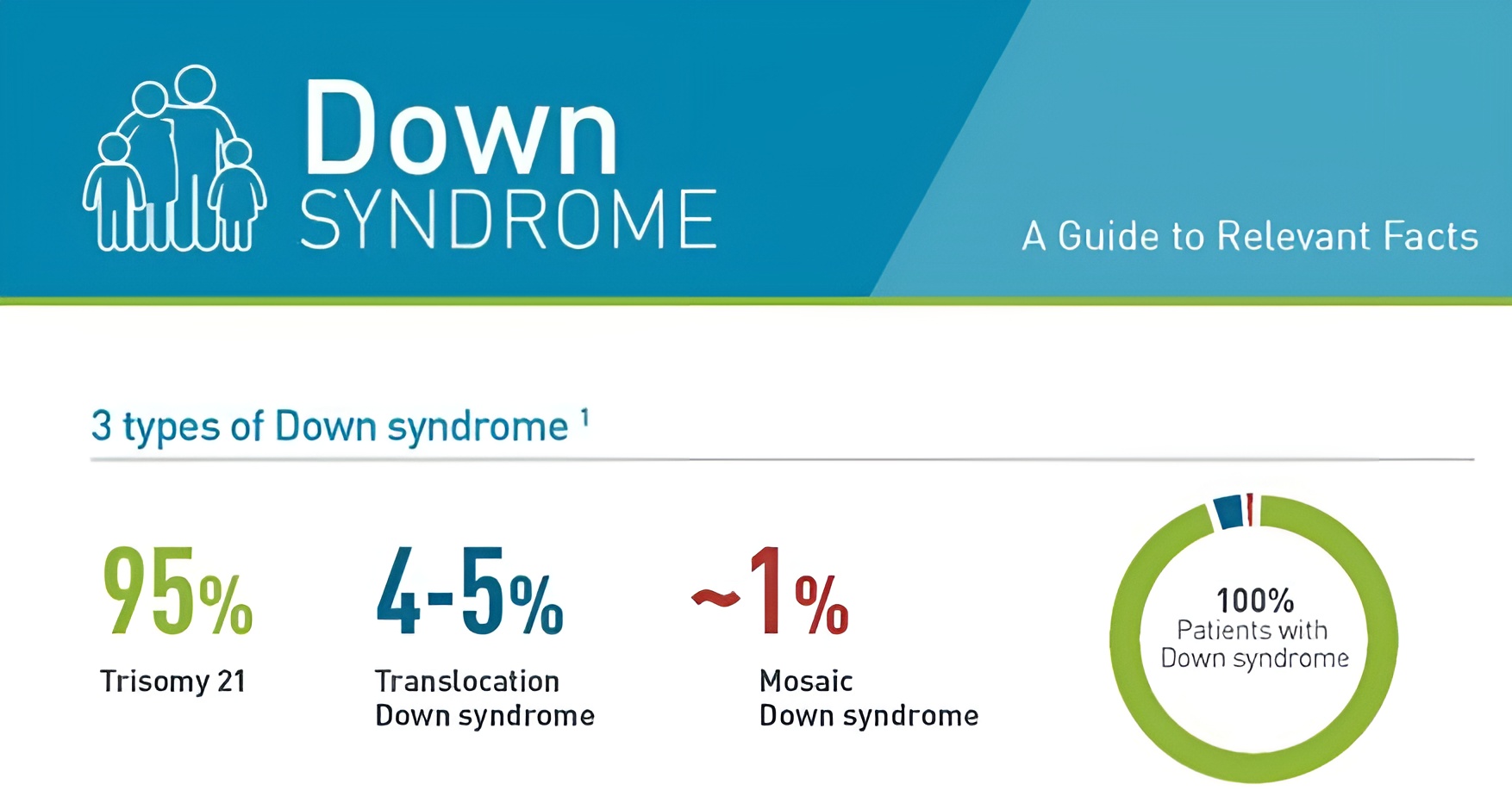
Causes of Down syndrome
Even though, we know that physical and developmental changes are caused by the extra chromosome 21, it has been possible to identify why it occurs and what causes it to occur.
Is Down syndrome a hereditary disorder?
Only 1% of all cases of Down syndrome are inherited. Heredity does not occur in Trisomy 21 or mosaicism Down syndrome, Since the extra chromosome 21 is due to a mistake in cell division during early stages of embryonic development. However, translocation Down syndrome may be inherited from one generation to the other. Even then only a few of the translocation Down syndrome are inherited.
Maternal age and its effect on incidence of Down syndrome
Advanced Maternal age is one of the risk factors for having a baby with Down syndrome because as the egg undergoes the aging process, its capacity to divide properly during cell division decreases. After the age of 35, the risk of Down syndrome is significantly high. However, due to many women having children under 35 years of years, nearly 51% of babies with Down syndrome are born into this category.
| Woman’s Age | Risk of Down syndrome |
|---|---|
| 20 | 1 in 2000 |
| 25 | 1 in 1200 |
| 30 | 1 in 900 |
| 35 | 1 in 350 |
| 37 | 1 in 250 |
| 39 | 1 in 150 |
| 40 | 1 in 100 |
| 45 | 1 in 30 |
| 49 | 1 in 10 |
Can a second child get affected as well?
Trisomy 21: When a couple gives birth to a child with Down’s syndrome, the chances of having another baby with the same condition is 1 in 100 until the age of 40
Translocation: The risk of having a second child with Down’s syndrome after the first depends on which parent is the carrier. If the mother is the carrier, there is a 10-15% chance of recurrence of translocation and if the father is the carrier, there is a 3% chance of recurrence.
Diagnosis of Down syndrome
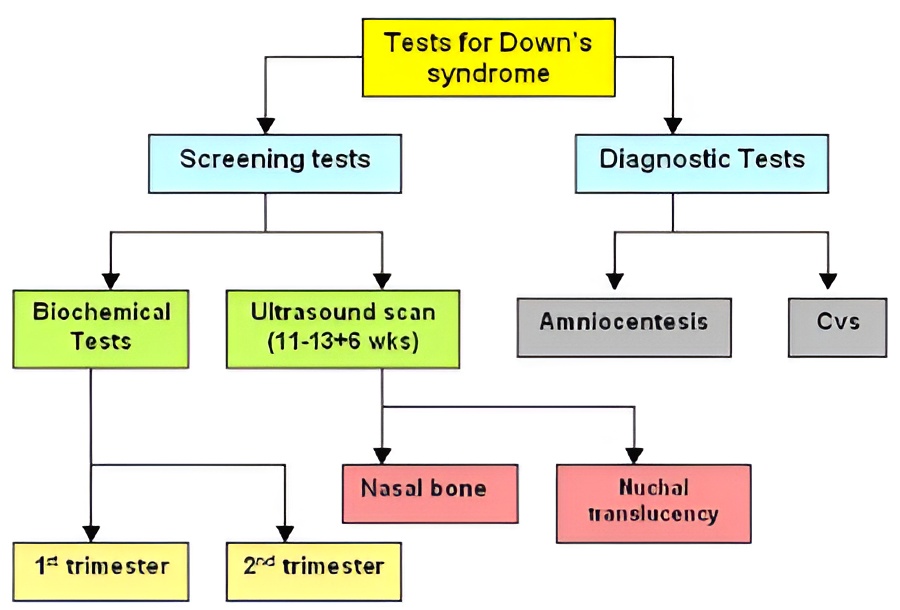
Prenatal tests:
There are two categories, which are
- Screening tests: These tests only provide the probability of a fetus having Down syndrome. But they do not tell for sure if the baby has Down syndrome.
- Serum screening tests
- Ultrasonographic test: Nuchal translucency test
- Integrated screening test: It is done in two parts (1st and 2nd trimester). The risk is estimated by combining the results.
- • First trimester: Integrated tests which include double marker and NT scan
- • Second trimester: The quadruple screening test which tests for four serum markers.
- Other tests: Non-invasive prenatal testing - These tests have a high accuracy rate but they are still not diagnostic
- Diagnostic tests: These tests provide 100% accuracy. These tests are invasive and carry a low risk of infection, miscarriage, etc.,
- Chorionic villous sampling - Placental cells are used to analyze the fetal chromosomes.
- Amniocentesis - amniotic fluid is usually collected in the second trimester and tested for chromosomal abnormality.
Postnatal test:
After birth, Down syndrome can be identified by the presence of physical characteristics mentioned above which are common in this condition. However, these traits can be seen in non-Down syndrome babies as well, hence to confirm the diagnosis karyotyping is done by drawing blood samples from the baby. Fluorescence in situ hybridization is another option to confirm the diagnosis.
Down syndrome Treatment
There is no cure for Down syndrome. However, a better understanding of the condition and early interventions such as speech therapy, physical therapy, proper health care, special education, regular screening for health issues, and financial and social support can increase the quality of life for people with Down syndrome. A care team that includes doctors, teachers, and therapists can provide the needed support and care.
Life expectancy
Nearly a century back, People with Down syndrome had a life expectancy of only 9-10 years. Today due to advancements in medical research and treatment, Life expectancy is 60 years or more. Each person with Down syndrome has unique talents and the ability to survive. With proper preparation and guidance, they can lead fulfilling lives and can even make world records as follows
First-person with Down syndrome to receive a BAFTA award: Paula Sage

The first fashion designer with Down syndrome to exhibit her work at London fashion week: Isabella Springmuhl Tejada

First musician with Down syndrome to have played seven instruments at the Carnegie Hall: Sujeet Desai

Prevention
We cannot prevent Down syndrome, however, if there is the presence of any one of the following risk factors,
- Advanced maternal age
- Either or both parents being carriers
- Previous child with Down syndrome
Consultation with a genetic counselor is important for the parents to understand their chances of getting a baby with Down syndrome and their options for early diagnosis and care.
Embark on a journey toward competence in diagnosing Down syndrome risk during the first-trimester scan by enrolling in our First-Trimester Ultrasound Course at Medline Academics. Delve deeper into fertility preservation strategies aimed at mitigating the impact of aging on oocytes by joining our Fellowship in Reproductive Medicine at Medline Academics. Gain comprehensive insights and specialized skills crucial for effective medical practice in these fields.
